Abstract
After 47 years and 60 volumes, editorial policy in the scholarly journal of the Herpetological Association of Africa has changed from largely unscientific to strictly scientific. I investigate the causes for this by examining the changes in editorial policy throughout the history of the journal and find that there has been a gradual change with some important milestones. Of key importance were the introduction of the peer-review process in 1979 and the inception of a newsletter in 1983. Interest in African herpetology is growing and the quality and quantity of articles in African Journal of Herpetology are seen to continue to increase. The future may include changes in the way that the content is produced, but will continue to provide a platform for herpetological discoveries on the African continent; thereby verifying the maxim: ex Africa aliquid semper novi.
Keywords:
Donald G. Broadley founded the Herpetological Association of Africa in 1965, together with The Journal of the Herpetological Association of Africa. This first issue of Volume 1 contained an editorial by Broadley, which stated: “The Journal is not intended to be a medium for the publication of scientific papers and it should not be quoted in the literature” (Broadley Citation1965, Citation1996). This year, 2011, we have reached Volume 60 and over the 47 years of publications have come to a diametrically opposed editorial policy, to wit: the African Journal of Herpetology is intended solely as a medium for the publication of scientific papers and is regularly quoted in the general scientific literature. However, the subject matter of the journal has remained the same, pertaining to African reptiles and amphibians. So how did this remarkable turn-around come about and what is the future of African Journal of Herpetology?
This history of the Herpetological Association of Africa (HAA) has been well documented from its beginnings to 1996 by Broadley (Citation1996). The first 15 volumes were edited by Broadley, in which he also undertook the majority of authorship (indeed it was Volume 3 before there was an article by anyone but Broadley). Broadley's contributions to African herpetology continued to be outstanding and were detailed when he reached the age of 65 and the HAA, which he founded, reached 40 years old (Branch Citation1997). However, it should be noted that Broadley's contributions have not stopped and he has continued to publish on African herpetology since his ‘retirement’ so that his publications now number around 230, with more in preparation (D. Broadley, pers. comm.).
In this mini-review I review changes in editorial policy and sample six volumes of publications across the 60 published to date (all are now available online and free of charge to HAA members at the portal: www.tandfonline.com). Changes in subject matter, references, author numbers and addresses are summarised in order to make predictions about the future of African Journal of Herpetology.
METHODS
To review changes in editorial policy and articles published by the journal over its 60 volumes, I have taken two separate approaches. First was to take a qualitative look at milestones in editorial policy of the journal to show timing of the change from Broadley's original stance outlined in Volume 1 (see above) to the current diametrically opposed editorial policy in today's journal. Second, I have taken a more quantitative approach in sampling six volumes, representing ‘snap-shots’ of the journal over its full publication history, to provide information on the change in articles published during this period. The mean (and standard error [SE]) of number of authors and references were recorded for each volume (not including material such as editorials, bibliographies, member announcements, book reviews, trivia, etc.), together with the country of their address. Subject matter was determined by a retrospective application of keywords which were converted to Wordles (word clouds in which the frequency determines the size of the word: www.wordle.net) and by identifying which herpetological order the article focuses on. Lastly, I review the contents of Volume 60 comparing it with other publications on African reptiles and amphibians (via a search for ‘Africa* AND amphibia*’ and ‘Africa* AND reptil*’ on Web of Science, Thomson Reuters from 1980 to 2010) using their system of key words (KeyWords Plus). I then use these summaries to highlight trends and future directions for the African Journal of Herpetology and African herpetology as a whole.
RESULTS AND DISCUSSION
Past
The summary of milestones for the journal shows that for the first 15 years, the Journal of the Herpetological Association of Africa published ‘non-technical’ articles that principally informed other readers of how to keep and breed a variety of African reptiles and amphibians (; & 2). Articles were generally single-authored (mean = 1.06; SE = 0.06) and rarely included references (mean = 0.94; SE = 0.47). Peer-review was introduced in 1979 for ‘semi-technical’ articles, although authors were still advised to submit technical articles to other journals (Channing Citation1979). Within a few years, all articles were submitted to full peer-review (Branch Citation1983). While the subject matter remained similar, articles were generally multi-authored (mean = 1.25; SE = 0.16) and each included a number of references (mean = 6.13; SE = 2.98; ). At this time, introduction of a newsletter provided a vehicle for much that was considered ‘non-technical’, and this saw the subject matter of the journal containing more scientific key words (–6). Subsequent editors moved more and more ‘non-technical’ content over to the newsletter to allow journal space to be dedicated to scientific content (). The numbers of authors and references per paper continue to rise steeply and this trend is particularly prominent between Volumes 40 and 60 (–6).
Figure 1. Volume 10 of the Journal of the Herpetological Association of Africa was published in 1973 and contained nine articles on a mixture of topics relating in the main to husbandry and of snakes and lizards. Each article had an average of 1.1 references (only one-third of articles contained references) and one author, with contributions from South Africa, Zimbabwe and the USA.
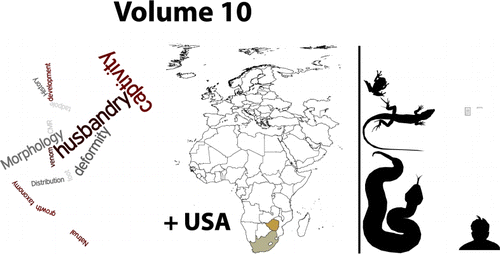
Figure 2. Volume 20 found the Journal of the Herpetological Association of Africa edited by Channing with most articles on anurans, concentrating on distribution with more articles on husbandry of snakes and lizards. In addition to South African contributions, a number of projects are listed by a Zambian herpetologist.
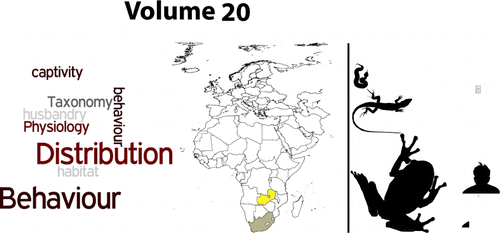
Figure 3. Volume 30, with Branch as Editor, saw the majority of articles swinging back to ophidians and their distribution, and to a lesser extent husbandry. More authors appeared per article (mean = 1.25; SE = 0.16), from South Africa and Europe as well as a mean of 6.13 (SE = 2.98) references.
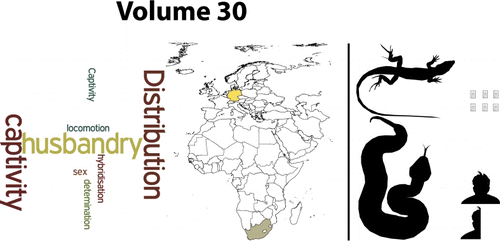
Figure 4. Volume 40 continued with Branch as Editor and has a wider range of herpetofauna with an increasing emphasis on taxonomy. The number of authors (mean = 1.56; SE = 0.20) and references (mean = 7.94; SE = 2.40) increased slightly, and contributions were mainly from southern Africa and the USA. It should be noted that Volume 40 contained the proceedings of the second HAA Symposium at Bloemfontein.
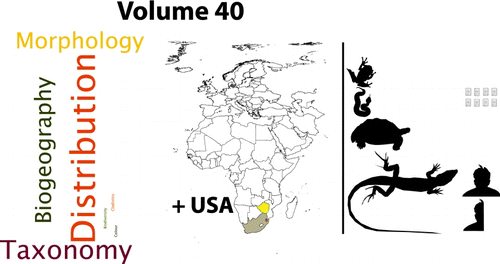
Figure 5. Volume 50 had Alexander as Editor and saw a dramatic increase in the scope of the journal's subject areas and number of references (mean = 34.40; SE = 7.41). Taxa covered remained similar, as did the number of authors (mean = 1.8; SE = 0.39) and their countries (southern Africa, Europe and USA).
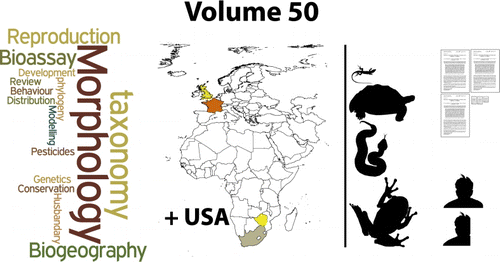
Figure 6. Volume 60 was edited by Measey, seeing authors from many more African countries including Madagascar, Nigeria and Rwanda. While the number of references stayed similar (mean = 35.35; SE = 4.99), the mean number of authors markedly increased to 3.14 (SE = 0.36). Gymnophiona featured in addition to other African herpetofauna previously seen.
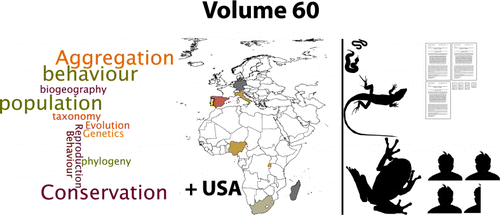
Table 1. Milestones in editorial policy and growth of African Journal of Herpetology
Gradual changes in editorial policy, particularly related to peer-review and the movement of non-peer-review items to a newsletter, are responsible for remodelling African Journal of Herpetology from Broadley's first editorial policy in 1965 to that of today (). Scientific interest in African herpetology has grown () and there is still great value in the contents of the early volumes, just as the current issues of the newsletter appeal to much the same audience. Editorial policy of African Herp News has also changed over time such that many of the articles submitted there are also subject to peer-review (at the Editor's discretion [Maritz Citation2010]). Despite the changes, some aspects of the journal have remained unchanged. The subject matter, African reptiles and amphibians, continues without any editorial policies broadening the scope. Journal editors remain unpaid and their work is largely conducted in evenings and at weekends. Despite the challenging and sometimes hazardous nature of African herpetology, all present and past editors (see ) are currently alive and well, and perhaps more noteworthy is that all are still active herpetologists.
Figure 7. The increasing popularity of African herpetofauna in the scientific literature, as evidenced by search results on Web of Science, Thomson Reuters. Reptiles (black bars from a search for ‘Africa* AND reptil*’) and amphibians (grey bars from a search for ‘Africa* AND amphibia*’) show a similar trend for the years selected.
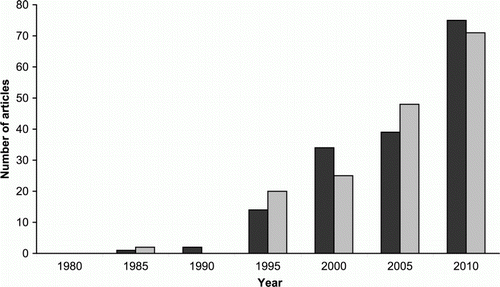
Present
As the popularity for research on Africa's herpetofauna increases (), so the quantity of submissions to African Journal of Herpetology increases, enabling editorial policies that can select for increasing scientific quality. Current editorial policy extends Whiting's (Citation1998) preference for hypothesis-driven research by making it a requirement. Authors are also required to abide by an ethical code (as are reviewers and editors), which can be found at the journal's websites (www.africanherpetology.org and http://www.tandfonline.com/ther). Scientists are human and do behave badly (Martinson et al. Citation2005; Benos et al. Citation2005), and the ethical code exists to protect all concerned in the publishing of articles. While guidelines cannot be strictly enforced, since the introduction of the code there has been a rejection of several submissions that fell outside of the guidelines. Authors are asked to declare their adhesion to the African Journal of Herpetology ethical code during their manuscript submission through our online manuscript tracking system, ScholarOne (http://mc.manuscriptcentral.com/ther).
Figure 8. Wordles of Thomson Reuters’ Web of Science KeyWords Plus for (A) all articles on African herpetofauna in 2010 compared with (B) those published in African Journal of Herpetology. Shared prominent keywords are ‘conservation’, ‘phylogeny’ and ‘evolution’.
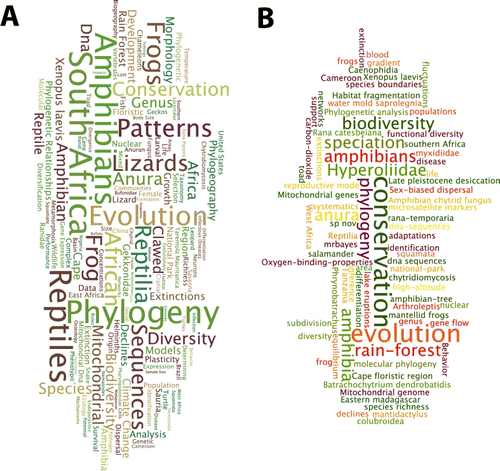
All submissions have double-blind peer-review (neither names of authors or reviewers are disclosed), a policy which prevents discrimination based on author identity (Budden et al. Citation2008), and is preferred by the majority of publishing scientists (Ware Citation2011). Multiple rounds of peer-review are onerous on authors, editors and reviewers and are avoided where possible. In most cases, multiple rounds of peer-review could be avoided by more careful preparation or thorough reworking of manuscripts by authors, and we urge all prospective authors to be rigorous in their manuscript preparation. When peer-review substantially increases the quality of an article, multiple rounds appear to be in the interest of both authors and editors. Recent data across all scientific disciplines suggest that peer-review does improve published material, as well as dealing with academic misconduct (Ware Citation2011). The referees of African Journal of Herpetology provide an invaluable service to the journal and to African herpetology and I would like to take this opportunity to extend my renewed thanks to them. However, soliciting reviews from referees is becoming more difficult, and it is important for all to realise that the peer-review system is a reciprocal process. The principle objective is that publication in African Journal of Herpetology should represent excellent scientific work on the reptiles and amphibians of Africa above any other concern, and the editorial team is particularly interested in receiving submissions from authors throughout the continent. To this end, I am very happy to reiterate that there are no publication fees in African Journal of Herpetology (unless colour printing is required; colour in electronic media is free). In addition, we now host online supplementary information for articles that require additional detail not produced in print.
The ‘Don Broadley prize for excellence in African Herpetology’ honours Donald G. Broadley by recognising the student who publishes the most outstanding manuscript in the preceding two volumes of African Journal of Herpetology. Candidates declare their application at the time of submission, and these are judged by the editorial committee with the prize presented at the HAA meeting. It is intended that the prize encourage students to submit their best work to African Journal of Herpetology as well as recognising and rewarding the hard work of students who work on African reptiles and amphibians. The first prize awarded for articles published by students in Volumes 58 and 59 was awarded jointly to Gavin Masterson (Masterson et al. 2009) and Anita Meyer (Meyer et al. 2010). We greatly look forward to judging the next round of student prizes.
Interest is increasing in African herpetology, as demonstrated by the dramatically increasing numbers of articles on Web of Science (WoS), especially since the late 1990s (), which is when African Journal of Herpetology was added to the WoS (). A comparison of keywords published for African reptiles and amphibians in 2010 by WoS shows a similarity with those published by African Journal of Herpetology (). ‘Phylogeny’, ‘conservation’ and ‘evolution’ all come out as strong subject areas in African Journal of Herpetology and other journals that publish papers on African herpetofauna.
Volume 60
African herpetology in general, and publications in African Journal of Herpetology in particular, are still dominated by novel findings that encompass the disciplines of phylogenetic analysis, conservation and evolution. New species of reptiles continue to be described, with evidence coming from morphology and molecular data (Heineke et al. 2011; Gehring et al. 2011). Where adults are already described, descriptions are still required of other life-history stages (Sprague & Zimkus Citation2011). Relationships between taxa have traditionally used morphology, which can still provide important insights by using phylogenetic methodologies (Moyer & Jackson Citation2011), whereas phylogenies based on molecules alone (Van der Meijden et al. Citation2011; Salvi et al. Citation2011) can provide new hypothetical frameworks for insights into evolutionary pathways. Equally, the molecular approach can be used to provide biogeographical insight into species boundaries (Perera et al. Citation2011). Novel studies and observations on behaviour and distribution can have important implications for conservation (Martín et al. Citation2011; Wilmes et al. Citation2011; Channing & Wahlberg Citation2011; Yetman & Ferguson Citation2011; Tessa et al. Citation2011; Measey et al. Citation2011), which has become an important aspect of African herpetology as habitat destruction continues unabated in areas that have been poorly explored. In addition to habitat destruction, anthropogenic impact on African herpetofauna can be more direct in areas where reptiles and amphibians are used as food (Mohneke et al. Citation2011). Lastly, some subject areas have been the subject of many studies which require synthesis to provide new insight and stimulus for new generations of herpetologists (Mouton Citation2011).
Future
The world of scientific publishing is moving with great pace, and with it the African Journal of Herpetology. In addition to our commitment to publishing hard issues of the journal, all of our content is published online and is freely available to HAA members. This also makes it possible to include more information that is not printed. In future, this could include a change from the current double-blind peer-review policy to one of transparency (Pulverer Citation2010), where the reviewers’ comments and rebuttal by authors are available to view. The online version could contain more varied peer-reviewed supplementary articles. In addition, it is hoped that the increasing numbers of herpetological journals will increasingly work together in future. For example, there may be the opportunity to introduce cascading reviews (De Schutter Citation2007). Importantly, authors will soon be required to deposit all raw data into public repositories, which allow storage and access to datasets (Reichman et al. Citation2011). Data-sharing is fast becoming an industry standard, in much the same way that deposition of genetic data is already compulsory for African Journal of Herpetology, ensuring a more rigorous and transparent publishing process.
In addition to possible changes in the way articles are reviewed and published, we look to increase the numbers of authors from more African countries. It has always been a frustrating irony that most herpetologists live and work in areas of the least herpetological diversity, and this is particularly true of Africa. We would welcome more submissions from more countries in Africa, and would be especially pleased if, in 10 volumes time, we could see much more of the continent covered in terms of authorship (see ). Americans and Europeans have been consistent contributors to African Journal of Herpetology, and we can only wonder whether African herpetofauna will begin to interest the burgeoning scientific power houses of India and China.
I sincerely hope that the pages of future volumes of African Journal of Herpetology will continue to fascinate those of you who have followed from Volume 1, as it does for those readers for whom this is the first of many copies. With certainty, I can predict that Broadley's motto adopted for the journal will continue to stand true for its herpetofauna: ex Africa aliquid semper novi.
ACKNOWLEDGEMENTS
I would like to thank all editors and associate editors of the journal for their help in compiling this mini-review. Special thanks to Donald G. Broadley (Bulawayo Museum, Zimbabwe) for his personal insights and continued interest. I dedicate this piece to all former African Journal of Herpetology editors who, through their hard work, have made the journal the excellent publication that it is today.
References
- Budden , A.E. , Tregenza , T. , Aarssen , L.W. , Koricheva , J. , Leimu , R. and Lortie , C.J. 2008 . Double-blind review favours increased representation of female authors . Trends Ecol. Evol. , 23 : 4 – 6 .
- Broadley , D.G. 1965 . Editorial. J. Herpetol . Assoc. Africa , 1 : 1
- Broadley , D.G. 1996 . A history of the Herpetological Association of Africa . Afr. Herp. News , 25 : 1 – 4 .
- Benos , D.J. , Fabres , J. , Farmer , J. , Gutierrez , J.P. , Hennessy , K. , Kosek , D. , Lee , J.H. , Olteanu , D. , Russell , T. , Shaikh , F. and Wang , K. 2005 . Ethics and scientific publication . Adv. Physiol. Ed. , 29 : 59 – 74 .
- Branch , W.R. 1983 . Editorial comment . J. Herpetol. Assoc. Africa , 29 : 1
- Branch , W.R. 1997 . A tribute to Don Broadley: Africa's premier herpetologist . Afr. J. Herpetol. , 46 : 58 – 67 .
- Channing , A. 1979 . Editorial . J. Herpetol. Assoc. Africa , 21 : 1
- Channing , A. and Wahlberg , K. 2011 . Distribution and conservation status of the desert rain frog Breviceps macrops . Afr. J. Herpetol. , 60 : 1 – 12 .
- De Schutter , E. 2007 . Neuroscience leading the way: reviews cascade by the INCF . Neuroinform , 5 : 205 – 206 .
- Gehring , P.-S. , Ratsoavina , F. , Vences , M. and Glaw , F. 2011 . Calumma vohibola, a new chameleon species (Squamata: Chamaeleonidae) from the littoral forests of eastern Madagascar . Afr. J. Herpetol. , 60 : 130 – 154 .
- Heinicke , M.P. , Adderly , L.M. , Bauer , A.M. and Jackman , T.R. 2011 . A long-known new species of gecko allied to Pachydactylus bicolor (Squamata: Gekkonidae) from the central Namibian coast . Afr. J. Herpetol. , 60 : 113 – 129 .
- Maritz , B. 2010 . Editorial . African Herp News , 52 : i
- Martinson , B.C. , Anderson , M.S. and de Vries , R. 2005 . Scientists behaving badly . Nature , 435 : 737 – 738 .
- Martín , J. , Polo-Cavia , N. , Gonzalo , A. , López , P. and Civantos , E. 2011 . Social aggregation behaviour in the North African amphisbaenian Trogonophis wiegmanni . Afr. J. Herpetol. , 60 : 1 – 6 .
- Masterson , G.P.R. , Maritz , B. , Mackay , D. and Alexander , G.J. 2009 . The impacts of past cultivation on the reptiles in a South African grassland . Afr. J. Herpetol. , 58 : 71 – 84 .
- Measey , G.J. , Hinkel , H.H. , Dumbo , B. and Fischer , E. 2011 . Rediscovery of Boulengerula fischeri, with notes on its morphology and habitat . Afr. J. Herpetol. , 60 : 47 – 59 .
- Meyer , A. , P.L.F.N. Mouton & L. Mucina . The biogeographical influence of the Tankwa Karoo Basin on reptile distribution in south-western South Africa . Afr. J. Herpetol. 59 : 53 – 64 .
- Mouton , P.L.F.N. 2011 . Aggregation behaviour of lizards in the arid western regions of South Africa . Afr. J. Herpetol. , 60 : 1 – 16 .
- Mohneke , M. , Onadeko , A.B. and Rödel , M.-O. 2011 . Medicinal and dietary uses of amphibians in Burkina Faso . Afr. J. Herpetol. , 60 : 78 – 83 .
- Moyer , K. and Jackson , K. 2011 . Phylogenetic relationships among the stiletto snakes (genus Atractaspis) based on external morphology . Afr. J. Herpetol. , 60 : 30 – 46 .
- Perera , A. , Sampaio , F. , Costa , S. , Salvi , D. and Harris , D.J. 2011 . Genetic variability and relationships within the skinks Eumeces algeriensis and Eumeces schneideri using mitochondrial markers . Afr. J. Herpetol. , 60 : 1 – 12 .
- Pulverer , B. 2010 . Transparency showcases strength of peer-review . Nature , 468 : 29 – 31 .
- Reichman , O.J. , Jones , M.B. and Schildhauer , M.P. 2011 . Challenges and opportunities of open data in ecology . Science , 331 : 703 – 705 .
- Salvi , D. , Bombi , P. and Vignoli , L. 2011 . Phylogenetic position of the southern rock lizard Australolacerta australis within the Lacertidae radiation . Afr. J. Herpetol. , 60 : 60 – 69 .
- Sprague , J. and Zimkus , B.M. 2011 . Description of the tadpole of Amietophrynus brauni (Anura: Bufonidae) from the West Usambara Mountains, Tanzania . Afr. J. Herpetol. , 60 : 70 – 77 .
- Tessa , G. , Guarino , F.M. , Randrianirina , J.E. and Andreone , F. 2011 . Age structure in the false tomato frog Dyscophus guineti from eastern Madagascar compared to the closely related D. antongilii (Anura, Microhylidae) . Afr. J. Herpetol. , 60 : 84 – 88 .
- Van der Meijden , A. , Crottini , A. , Tarrant , J. , Turner , A. and Vences , M. 2011 . Multi-locus phylogeny and evolution of reproductive modes in the Pyxicephalidae, an African endemic clade of frogs . Afr. J. Herpetol. , 60 : 1 – 12 .
- Ware , M. 2011 . New review of information networking peer-review: recent experience and future directions . New Rev. Inf. Netw. , 16 : 23 – 53 .
- Whiting , M.J. 1998 . African Journal of Herpetology and the future of African herpetology . Afr. J. Herpetol. , 47 : 1 – 2 .
- Wilmes , A.J. , Siegel , D.S. and Aldridge , R.D. 2011 . Premature sperm ejaculation in captive African brown house snake Lamprophis fuliginosus . Afr. J. Herpetol. , 60 : 1 – 4 .
- Yetman , C.A. and Ferguson , J.W.H. 2011 . Spawning and non-breeding activity of adult giant bullfrogs (Pyxicephalus adspersus) . Afr. J. Herpetol. , 60 : 13 – 29 .